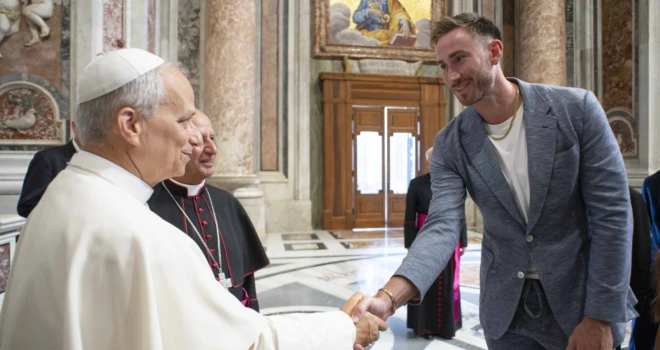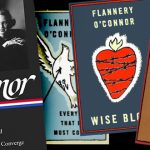A “return to Rome” usually signifies a reversion back to the faith of one’s youth, but with Hayward, it means going back to the place of his entry into the Catholic Church. This is what the 6-8 NBA All-Star forward did June 14-15 of this year, after having been received into the Church on October 1 last year in the Eternal City.
As a senior at Brownsburg High School in the 2007-08 season, Hayward led his team in scoring and rebounding, nailed the game-winning shot that clinched the state championship, and was named Indianapolis State Player of the Year. Despite all this success, however, Hayward was not highly recruited by colleges.
Instead of attending a perennial powerhouse, the 6-8 forward decided—reluctantly at first—to accept a scholarship to lowkey Butler University. To the surprise of many—including Hayward himself—he was part of the 2009-10 team that advanced to the championship game, ending the extraordinary season at 33-5.
Hayward was named the Horizon League Player of the Year and was later selected in the first round of the NBA Draft (ninth overall) by the Utah Jazz. After a successful career with the Jazz, Boston Celtics, Charlotte Hornets, and Oklahoma City Thunder (winners of the 2025 NBA Championship), the 2017 All-Star decided it was time to enter into full communion with the Catholic Church.
Now Holy Communion is the most important reality of Hayward’s life. He recently explained this—and the rest of his journey to the Church—to Trent Beattie in the following Q&A:
Before you entered college, did you know what bright things might be in store for you athletically?
Well, a funny story about Butler University involves me and my dad. He was driving me along I-465 near Butler’s campus in Indianapolis when I was in high school. He asked if I would consider attending, but I told him that if I wasn’t going to play Division I ball, I just wanted to go to college and not play at all.
The thing is, Butler is a D1 school, but I didn’t even know that at the time. In my high school world, Purdue, Indiana, and sometimes Notre Dame were the universities people talked about. Butler was just not on the radar. That was despite the fact that they had put together some very solid seasons even before the big 2009-10 run I was so blessed to be a part of.
Did the playing philosophy often called “The Butler Way” help you as a player in the NBA, too?
It sure did. “The Butler Way” was there even before Brad Stevens put Butler on the map. The five aspects of it—humility, passion, unity, servanthood, and truthfulness—are ways for players to realize their strengths and weaknesses and then interact effectively with each other in light of those strengths and weaknesses.
The aspect of teamwork is emphasized by almost any coach anywhere, but it takes someone special to really get players to live that. Everyone wants great personal stats, so it’s easy to think, “Yah, I’m for sacrifice—as long as other people do it.” Yet that true team spirit is what made our Butler teams so successful.
In 2017 you were named an All-Star. Was that something that arose naturally as you matured, or did you consciously decide before the season to be very focused and diligent?
The previous two or three seasons, I had come close to being named an All-Star, but my teams were not good enough. (They take into account not only personal stats, but how your play affects your team’s results.)
In the summer of 2016, I was invited to play on the U.S. Olympic Team, but I decided to stay home. The top two reasons were that my wife was expecting our second child, and I wanted to work harder than ever to prepare for the next season.
That intense focus paid off; I was named an All-Star during the 2016-17 season. That honor was also due to my team, whose overall play allowed me to succeed individually.
Your wife Robyn was a cradle Catholic, but had you been able to connect on theology and sports growing up outside the Church?
Absolutely—although it was not in a specifically Catholic way. The only reason I was able to get as far as I did in basketball is God’s gift to me of height and talent.
Coming from parents who are both under six feet tall is not the ideal recipe for success in the NBA. I’m the only person in my family over six feet tall. If you look at family photos, there’s pretty much a straight line and then there’s this mountain, which is me.
So I’ve always had some kind of theological appreciation for sports, but becoming Catholic has deepened that and given it more texture. Catholics see physical matter as being able to convey spiritual goods—as in all seven sacraments—and sports can be an extension of that.
At the same time, our Faith teaches us that sports are not the main purpose in life, that far greater realities await those who love the Lord and keep His commands, as we read in John 14.
I understood this even as a Lutheran. A story that stands out is how, the day before our big national championship game in 2010, I was being asked to sign my fellow churchgoers’ bulletins. It felt really odd, like I was seen as a saint whose relics people wanted.
Getting the “relics” of athletes, more commonly known as memorabilia, is just a hobby on a natural level, like gardening or cycling. Staying in a state of grace by imitating the lives of the saints is incomparably more important; relics of actual saints can be an aide to this.
When did you start to think of becoming Catholic?
As Robyn and I prepared for our wedding in the Church in 2014, I told the priest that, if I became Catholic, I wanted to do it not for the sake of appearances, but because I actually believed what the Church believes.
Despite not converting then, I was okay with our kids being raised Catholic, and I would attend Mass with the family without receiving Holy Communion. I had also started asking Joe Mazzulla, then my assistant coach with the Celtics, questions about what Catholics believe.
Joe prays the Rosary every day and introduced me to a priest-friend who answered even more of my dozens of questions. That priest, Fr. Marcel Taillon, helped me make my final moves toward the Church after I retired last year. He connected me with Archbishop Timothy Broglio of the Archdiocese of Military Services, USA, who was already going to be in Rome in October. The service was quite appropriately at the Basilica of St. Sebastian, since he is a patron of soldiers and athletes.
What else stands out in your mind about the experience?
There were so many great things—too many to recount—but near the top was going to Confession. I had been baptized, but had never gotten to let go of my post-baptismal sins. Most people don’t realize what a blessing it is to be able to tell your sins to Jesus through the priest and then be forgiven by Jesus through the priest.
That sacrament is far more complete than a simple, generic, silent asking for forgiveness. It removes the guilt of the sins, gives us strength to be more virtuous in the future, and makes present a solid hope of eternal life.
The feeling after that confession of 34 years was like no other—a lightness of body and soul, like you could float right into Heaven. Sin weighs us down, but grace lifts us up. That’s what the Catholic Church is about: transforming our souls to be worthy members of the body of Christ.
Have any books on the body of Christ (the Church) or the Body of Christ (the Holy Eucharist) been helpful in your conversion?
The Eucharist Is Really Jesus by Joe Heschmeyer has been very instrumental. Protestants tend to have a very casual, vague reading of the Bible passages in the Gospel of John, chapter 6. Catholics, on the other hand, take Our Lord at His word. He said repeatedly and emphatically that “this is my body.” Even when people left Him, He still persisted in His statements about what we now call the “Real Presence” or how the bread and wine are changed into the Body and Blood of Our Lord.
The title of the book says it all: The Eucharist Is Really Jesus. This central belief of our Faith explains all the other beliefs; it’s the highest of the Sacraments; it’s why we kneel in silence at the Consecration; it’s why we prepare our souls to receive Holy Communion worthily; it’s why we’ve built magnificent churches over centuries and composed beautiful hymns like Pange Lingua, sung especially on Holy Thursday and the Feast of Corpus Christi.
It’s also why we adore Our Lord outside of the Mass, where the reserved Eucharist is called the Blessed Sacrament. That can happen at any parish, but it was seen in an extraordinary way last year in my hometown of Indianapolis at the Eucharistic Congress, where tens of thousands of pilgrims professed their belief that Our Lord is truly with us today—not just in a theoretical or symbolic way, but in a very real, sacramental way.
A logical consequence of an appreciation for the Eucharist is an appreciation for the Blessed Virgin Mary, who, through her “fiat” made the Incarnation possible. This Incarnation continues today, since the Word is made flesh and dwells among us at every Mass.
This is a profoundly and shockingly beautiful thing that could never be explained fully here, but we have, after the Holy Trinity of course, Mary to thank for this reality.
Do you pray the Rosary daily and have you read Marian classics such as True Devotion to Mary, a favorite of the Seattle Seahawks’ Abe Lucas?
I do pray the Rosary, but have not yet gotten to daily recitation of it. Like the prayers of the Mass itself, I’m in the beginning stages of this set of prayers. I know experienced Catholics think of the Our Fathers, Hail Marys, and Glory Bes as “background music” or as a “soundtrack” to their meditation on the Joyful, Sorrowful, Glorious, and Luminous mysteries, but I’m still thinking of what each of the prayers means.
Maybe after reading True Devotion to Mary by St. Louis de Montfort or The Glories of Mary by St. Alphonsus or Champions of the Rosary by Fr. Calloway, I’ll get into the daily habit.
Why were you back in Rome this year?
I was back in the Eternal City this year in the middle of June for the Jubilee of Sports, a specific aspect of the Church’s overall Jubilee Year. I spoke at an event about my conversion, how sports can be overdone in our culture, but how they can also be great ways to practice virtue, etc.
I also attended a Mass offered by our new Holy Father, Pope Leo XIV. I was even able to meet him beforehand. He was standing right next to the famous, marble Pieta statue, a scene which is a visual reminder of how priests are not there for their own purposes, but for promoting the Catholic Faith.
For years I’ve had a general respect for the Church, but now that respect has become deeper and more detailed. I want to be the best husband and father I can be. We now have five kids—four born and one to be born—so my job is to make sure they become the best possible followers of Christ.
Photo provided by the Author














